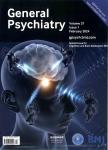Influencing factors of the neurodevelopment of high-risk infants
Influencing factors of the neurodevelopment of high-risk infants作者机构:Department of Child Health Management Children's Hospital of Shanghai Department of Child Healthcare Shanghai Jingan Maternity and Infant Health Hospital Department of Child Healthcare Shanghai Jiading Maternity and Infant Health Hospital Department of Child Healthcare Shanghai Putuo Maternity and Infant Health Hospital
出 版 物:《General Psychiatry》 (综合精神医学(英文))
年 卷 期:2018年第31卷第6期
页 面:140-145页
核心收录:
学科分类:0402[教育学-心理学(可授教育学、理学学位)] 1004[医学-公共卫生与预防医学(可授医学、理学学位)] 1002[医学-临床医学] 1001[医学-基础医学(可授医学、理学学位)] 10[医学] 1009[医学-特种医学]
基 金:funded by the'Three-Year Action Plan for Strengthening the Public Health System in Shanghai(2015-2017)–Management of High-risk infants with Multidisciplinary Cooperation' project number:GWIV-19
主 题:infants high-risk factors abnormalities developmental
摘 要:Background High-risk infants refer to newborns exposed to high-risk factors in the prenatal, natal or postnatal period. High-risk infants are at high risk of developmental retardation, and early identification of developmental abnormalities plays a vital role in improving high-risk infants quality of life.Aims To describe the neurodevelopment of high-risk infants aged less than 1 year old, and to analyse the incidences and influencing factors of neurodevelopmental abnormalities in order to provide a basis for neurodevelopment monitoring and management of highrisk infants.Methods High-risk infants born between January 2016 and December 2016 in the maternity and infant health hospitals of three districts in Shanghai were followed up.The Gesell Developmental Scale was used to assess the neurodevelopmental level at the time of recruitment(0-2 months) and at 9 months. Univariate and multivariate analyses of the influencing factors were conducted.Results 484 high-risk infants(male 51 %, female 49%)with an average gestation age of 36.5±2.2 weeks were recruited. At the time of recruitment, the average age was2.1(0.8) months, and the developmental quotient(DQ)scores of full-term high-risk infants in motor(t=3.542,p=0.001), cognitive(t=3.125, p=0.002), language(t=3.189, p=0.002) and social(t=3.316, p=0.001) areas were higher than those of preterm infants. The incidences of developmental abnormalities of full-term high-risk infants in motor(χ~2 =9.452, p=0.002), cognitive(χ~2=6.258, p=0.012), language(χ~2 =12.319, p =0.001) and social(χ~2 =6.811, p=0.009) areas were lower than the preterm infants. At 9 months, there was no difference in the DQ scores and incidences of developmental abnormalities in four areas between full-term and preterm high-risk infants, and the incidence of developmental abnormalities was around 10%.Conclusion The incidence of neurodevelopmental abnormalities in high-risk infants aged less than 1 year old is high. Preterm birth and parental bad habits are significant factors affecting the neurodevelopment.Monitoring and early interventions help to improve highrisk infants neurodevelopment.



